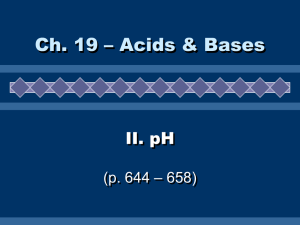Quantitative Problem Solving of Acids and Bases
advertisement
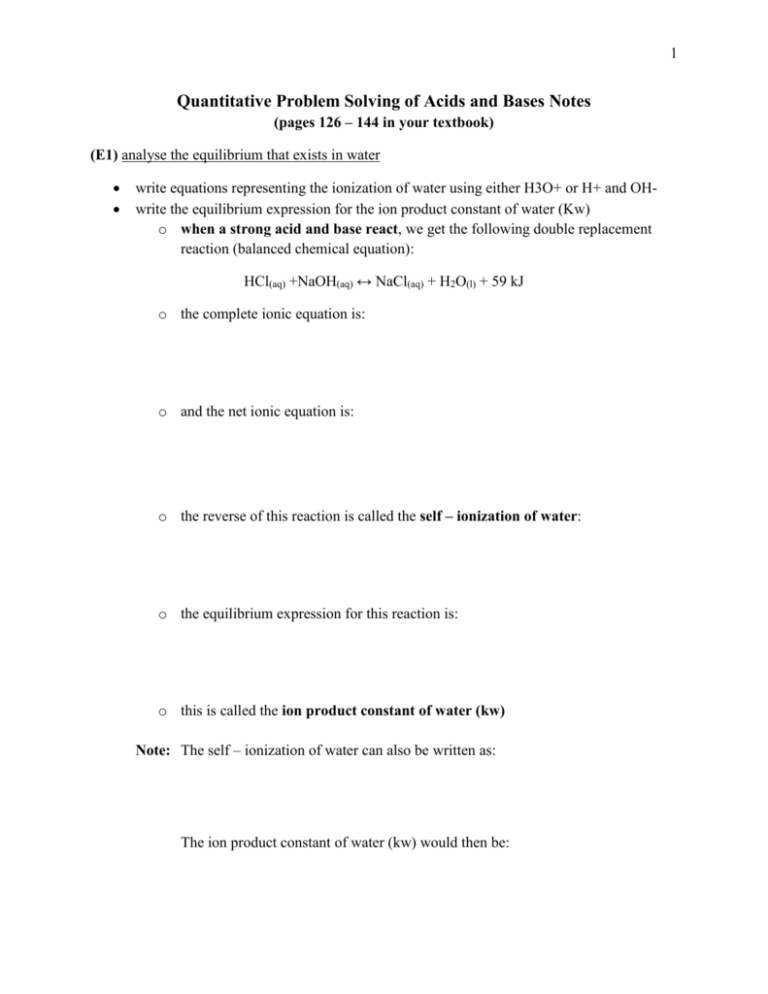
1 Quantitative Problem Solving of Acids and Bases Notes (pages 126 – 144 in your textbook) (E1) analyse the equilibrium that exists in water write equations representing the ionization of water using either H3O+ or H+ and OHwrite the equilibrium expression for the ion product constant of water (Kw) o when a strong acid and base react, we get the following double replacement reaction (balanced chemical equation): HCl(aq) +NaOH(aq) ↔ NaCl(aq) + H2O(l) + 59 kJ o the complete ionic equation is: o and the net ionic equation is: o the reverse of this reaction is called the self – ionization of water: o the equilibrium expression for this reaction is: o this is called the ion product constant of water (kw) Note: The self – ionization of water can also be written as: The ion product constant of water (kw) would then be: 2 state the value of Kw at 25°C describe and explain the variation in the value of Kw with temperature o In the Dynamic Equilibrium unit, we learnt that the equilibrium expression (keq) is a constant for a certain temperature. Therefore, the keq value does not change unless the temperature changes. o The ion product constant of water (kw), works in the same way. It is a constant for a certain temperature. o Kw at 25°C is: o However, if this temperature changes, then the value of Kw changes Determine how Kw changes when water is heated. calculate the concentration of H3O+ (or OH-) given the other, using Kw Determine [H3O+] and [OH-] in pure, neutral water. Do you think there might be some correlation between these concentrations and the pH scale? If so, explain. __________________________________________________________________ __________________________________________________________________ __________________________________________________________________ __________________________________________________________________ 3 What is the concentration of [H3O+] and [OH-] in 0.0010 M HCl(aq)? What is the concentration of [H3O+] and [OH-] in 0.5 M NaOH(aq)? predict the effect of the addition of an acid or base to the equilibrium system o As we learnt in the Dynamic Equilibrium unit, if we act to increase the concentration of a substance, the reaction will respond by decreasing it. Determine what happens when we add an acid to the equilibrium system. Determine what happens when we add a base to the equilibrium system. state the relative concentrations of H3O+ and OH- in acid, base, and neutral solutions In a neutral solution, In an acidic solution, In a basic solution, [H3O+] = [OH-] [H3O+] > [OH-] [H3O+] < [OH-] 4 (E3) explain the significance of the Ka and Kb equilibrium expressions write Ka and Kb equilibrium expressions for weak acids or weak bases o So far, we have dealt with strong acids and bases with 100% dissociation, where we only consider [H3O+] and [OH-]. This is not the case for weak acids and bases. o The equilibrium expression for a weak acid is the acid ionization constant (ka). o The equilibrium expression for a weak base is the base ionization constant (kb). o ka found in “Relative Strength of Brönsted-Lowry Acids and Bases” Table Determine the equilibrium expression for CH3COOH(aq). Determine the equilibrium expression for NH3(aq). How can you find the Kb value? 5 relate the magnitude of Ka (the acid ionization constant) or Kb (the base ionization constant) to the strength of the acid or base o the greater the ka value, the stronger the acid o the greater the kb value, the stronger the base What happens when you mix acids and bases? Consider H2CO3(aq) mixed with SO32-(aq). 6 (E2) perform calculations relating pH, pOH, [H3O+], and [OH-] define pH and pOH pH = – log10[H3O+] pOH = – log10[OH-] Logarithms and What They Means 1. The expression log10[x] means the logarithm to the base 10 of x Examples: log10[0.01] = – 2 Note: 0.01 = 10-2 (log10 just gets rid of the base 10) log10[1000] = log10[8.76 x 10-9] = log10[2.43 x 10-4] = 2. The opposite of log is antilog. Antilog[x] means 10 to the power of x. Examples: antilog[4] = 104 = 10 000 Note: antilog just puts it to the power of 10 antilog[–7] = antilog[5.12] = antilog[11.4] = 3. Combining logaritms. log[A x B] = log[A] + log[B] define pKw , give its value at 25°C, and its relation to pH and pOH pKw = – log10[kw] = – log10[1.00 x 10-14] = Note: This can also be expressed as pKw = pH + pOH 7 calculate [H3O+] or [OH-] from pH and pOH Note: In pH (pOH, or pKw), only the figures after the decimal are significant. The figure before the decimal comes from the nonsignificant figure in the power of 10. 1. If [H3O+] = 3.94 x 10-4, what is pH? 7. If pH is 6.330, what is [OH-]? 2. If pH is 4.798, what is the [H3O+]? 8. If pH is 4.44, what is [OH-]? 3. If [OH-] = 9.51 x 10-12, what is pOH? 9. If pOH is 8.09, what is [H3O+]? 4. If pOH is 9.106, what is [OH-]? 10. If pOH is 10.645, what is [H3O+]? 5. If pH is 9.355, what is pOH? 6. If pH is 6.577, what is pOH? 8 Use the following schematic to converting from pH and pOH to [H3O+] and [OH-] Note: When the pH is increase by 1, the [H3O+] is decreased by 10 describe the pH scale with reference to everyday solutions 9 (E4) perform calculations involving Ka and Kb calculate the value of Kb for a base given the value of Ka for its conjugate acid (and vice versa) o refer to outcome E3 on page #4 on this notebook calculate the value of Ka or Kb given the pH and initial concentration given the Ka, Kb, and initial concentration, calculate [H3O+], [OH-], pH, or pOH calculate the initial concentration of an acid or base, given the appropriate Ka, Kb, pH, or pOH values If 10.0 mL of 0.100 M HCl is added to 90.0 mL of 0.100 M NaOH, what is the pH of the mixture? 10 How many moles of HCl must be added to 40.0 mL of 0.180 M NaOH to produce a solution having a pH = 12.500, if it is assumed that there is no change in volume when the HCl is added?

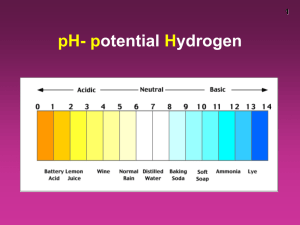

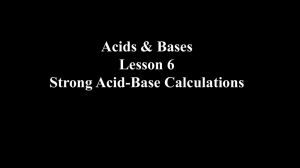
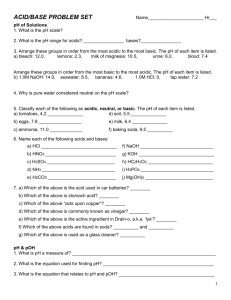
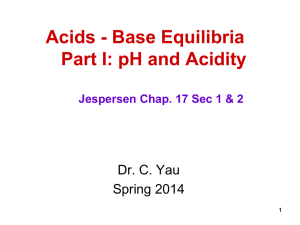
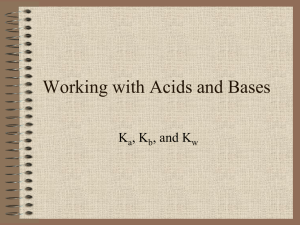
![[H + ] [OH ] - CCBC Faculty Web](http://s2.studylib.net/store/data/005793401_1-b043355121eb738cc68e8c8b1b02be73-300x300.png)
